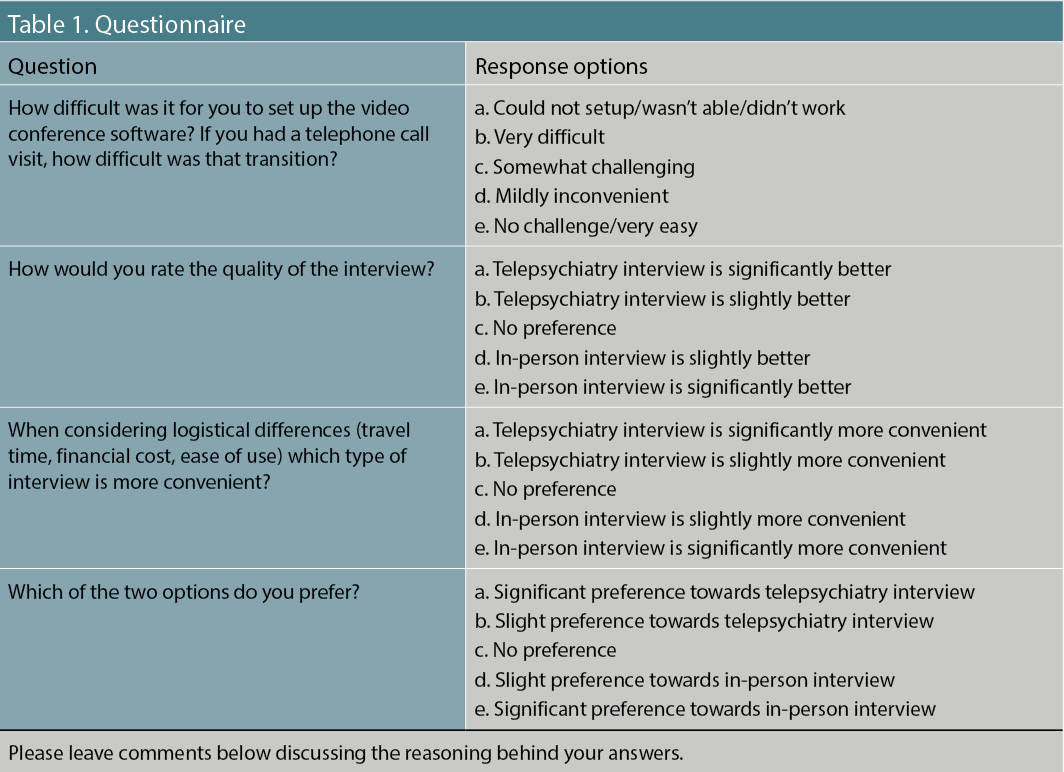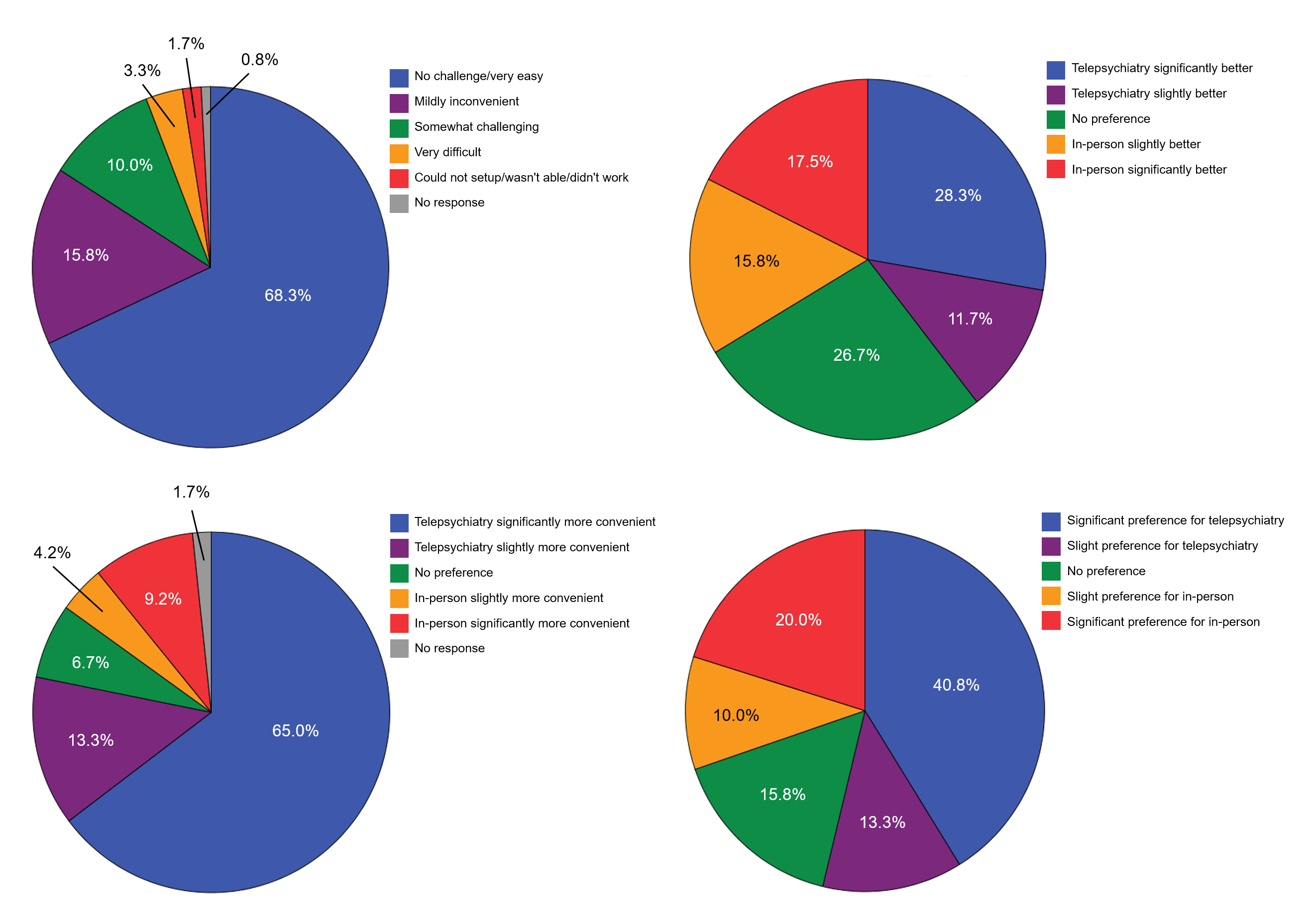Article
Telepsychiatry: Diverse Needs Require Diverse Options
Author(s):
COVID-19 has prompted an unprecedented shift toward virtual psychiatric health care—but how do patients and providers really feel about it?
insta_photos/Adobe Stock

First used decades ago, virtual psychiatric health care has been established as a viable alternative to in-person psychiatric services. In 2016, Hubley and colleagues performed a review of available research and concluded that a “large evidence base supports telepsychiatry as a delivery method for mental health services.”1 Luo et al established electronically delivered cognitive behavioral therapy (eCBT) as noninferior to in-person cognitive behavioral therapy (CBT) with respect to a variety of outcomes. They also found that eCBT is actually more effective than face-to-face CBT for reducing depression symptom severity.2
While implementation of telepsychiatric care had been steadily increasing, barriers to widespread use remained. The 2 primary barriers were regulatory burdens and logistical difficulties associated with reimbursement, according to Keesara et al.3 Then, in spring 2020, the COVID-19 pandemic necessitated virtual care, and these barriers were rapidly removed. The pandemic prompted a shift in outpatient psychiatry services from primarily face-to-face to primarily virtual. Given the unprecedented nature of this paradigm shift, literature from the pre-COVID-19 era has lost some degree of relevance. However, a wealth of research on telepsychiatric health care has been performed since March 2020.
Chen et al described early experiences, reviewed key regulatory changes enabling widespread telepsychiatry, and provided clinical insights and suggestions.4 Yellowlees and colleagues detailed anecdotal experience at University of California, Davis Health and described generally positive experiences from both the provider and patient points of view.5 Another group of investigators published a nationwide multisite survey on patient attitudes. Of the 14,000 patients who were surveyed, approximately 3000 responded and results generally favored use of telepsychiatry.6
In a retrospective cohort study of nearly 39,000 patient surveys, Ramaswamy et al found satisfaction with video visits to be significantly higher than satisfaction with in-person visits (94.9% versus 92.5%; p < 0.001).7 Additionally, Serhal and colleagues developed and validated a survey on patient satisfaction. They found that access, timeliness, and safety were predictors of patient satisfaction.8 Finally, a review on determinants of satisfaction showed the main determinants to be convenience and cost.9 It stands to reason that telepsychiatric care provides benefits associated with access, timeliness, safety, convenience, and cost, and current research generally indicates patient preference for virtual health care visits.
The psychiatric outpatient experience at Cleveland Clinic Akron General (CCAG) and its resident-run clinic has been rapidly and dramatically changed in response to the COVID-19 pandemic. Patient attitudes toward these changes (in particular, telepsychiatric care) have not been assessed. As such, our goal was to gather and report feedback—in both a quantitative and a qualitative manner—from our patients regarding their attitudes toward the conversion to virtual psychiatric care. We hope this feedback will allow us to improve delivery of care and other patient outcomes in the future.
Methods
Survey Development and Dissemination
The CCAG Institutional Research Review Board approved use of the minimum necessary protected health information for the conduct of this quality assurance initiative. Psychiatric patients at CCAG and its resident-run clinic who attended virtual visits (by video or phone conference) from April 1, 2020, to December 31, 2020, were identified by a review of electronic medical records. Email addresses for these patients were extracted. A short anonymous survey including a demographics section and a questionnaire was emailed to patients via the Research Electronic Data Capture (REDCap®) application, a secure web-based platform that automatically collects and stores responses. The questionnaire included 4 multiple-choice questions and 1 open-ended prompt and was designed to assess difficulty setting up video software/telephone, quality of visit, convenience, and overall preference (Table 1).
Table 1. Questionnaire

Data Analysis
Descriptive statistics were performed for data analysis using IBM SPSS (Version 24.0, Armonk, NY) statistical software. Frequencies with percentages, measures of central tendency, and measures of spread were presented as appropriate. Qualitative data in the form of responses to open-ended questions were also reported.
Results
A total of 1259 surveys were administered, and 120 (9.5%) patients responded. Self-reported demographics are presented in Table 2.
Table 2. Demographics

One hundred one (84.2%) patients indicated setup was no challenge or only mildly inconvenient, and 18 (15.0%) indicated they had significant setup difficulties. Forty-eight (40.0%) patients felt virtual visits were of higher quality, 32 (26.7%) expressed neutrality, and 40 (33.3%) indicated in-person visits were of higher quality. Ninety-four (78.3%) patients indicated virtual visits were more convenient, 8 (6.7%) indicated neutrality, and 16 (13.3%) indicated in-person visits were more convenient. Lastly, 65 (54.2%) patients expressed an overall preference for virtual visits, 19 (15.8%) expressed no preference, and 36 (30.0%) expressed a slight or significant preference toward in-person visits (Figure).
Figure. Patient perceptions of difficulty setting up virtual software/phone for visit (top left), quality of visit (top right), convenience (bottom left), and overall preference (bottom right).

Of the 120 respondents, 69 (57.5%) provided responses to the open-ended prompt. Of these, 32 (46.4%) expressed a preference for virtual visits, commented only on benefits of virtual visits, or commented only on drawbacks to in-person visits. Of their comments, 24 (75%) included language on convenience, 12 (37.5%) included language on comfort, 6 (18.8%) included language on safety (largely with respect to the COVID-19 pandemic), and 7 (21.9%) included language indicating virtual visits benefitted family and childcare situations. Thirteen (18.8%) respondents expressed a preference for in-person visits, commented only on benefits of in-person visits, or commented only on drawbacks to virtual visits. Their comments included language on the benefits of personal and emotional interactions, the ability to read body language, and the capacity to comfort and express care. The remaining 24 (34.8%) respondents did not express a preference, commented on benefits/drawbacks of both options, or did not provide a clear or relevant response.
Discussion
Our results indicate that a great deal of benefit can come from telepsychiatric care. These findings corroborate those of other groups.1,2 Conceivably, increased convenience coupled with comparable quality would predict a significant preference toward virtual visits. However, the actual trend observed was modest. This may be explained by the heterogeneous nature of our patient population. For example, differences in access to technology, technological proficiency, access to transportation, travel time, availability, and personal finances are just a few variables that account for differences in preferences and opinions.
Even differences in diagnoses play a role. Within free-response answers, many patients indicated that they felt more comfortable attending virtual visits given their struggles with agoraphobia. It is worthy to note, however, that this “benefit” may not be in some patients’ best interest. For example, some providers may feel that exposure to places and situations that cause discomfort is necessary for recovery.
There were some important limitations to this initiative. Results may have been influenced by selection and non-response bias. For example, given that the survey was administered via email, it stands to reason that patients who are more comfortable using computer technology may have been more likely to respond. Also, demographic data show that 60.5% of responders reported attainment of a bachelor’s degree or higher, and 28.6% reported having attended some college or obtaining an associate’s degree. As such, results largely reflect the opinions and preferences of more highly educated patients and, therefore, do not accurately represent those of our patient population as a whole. Other types of bias that may be at play include recall, acquiescence, and question order bias.
Concluding Thoughts
The best way to meet diverse needs is to offer diverse options. Telepsychiatry represents an option that may be well suited to some and not as well suited to others. To test for associations between patient opinions and factors such as demographics, baseline clinical characteristics, and diagnoses, formal research is required. Telepsychiatry is a branch of health care delivery still in its infancy, and there is much to be discovered. Future research will inform on optimal ways to provide individualized psychiatric care.
Dr Fondriest is a psychiatrist at LifeStance Health, Upper Arlington, Ohio. Dr George is a health scientist in the Department of Health Sciences at Cleveland Clinic Akron General, Akron, Ohio; she is also an assistant professor of psychiatry and a clinical assistant professor of obstetrics and gynecology at Northeast Ohio Medical University, Rootstown, Ohio. Dr Tampi is professor and chairman, Department of Psychiatry, Creighton University School of Medicine, Omaha, Nebraska, and chairman, Catholic Health Initiatives (CHI) Health Behavioral Health Services, Omaha, Nebraska.
References
1. Hubley S, Lynch SB, Schneck C, et al. Review of key telepsychiatry outcomes. World J Psychiatry. 2016;6(2):269-282.
2. Luo C, Sanger N, Singhal N, et al. A comparison of electronically-delivered and face to face cognitive behavioural therapies in depressive disorders: a systematic review and meta-analysis [published correction appears in EClinicalMedicine. 2021 Nov 02;41:101182]. EClinicalMedicine. 2020;24:100442.
3. Keesara S, Jonas A, Schulman K. Covid-19 and health care’s digital revolution. N Engl J Med. 2020;382(23):e82.
4. Chen JA, Chung WJ, Young SK, et al. COVID-19 and telepsychiatry: early outpatient experiences and implications for the future. Gen Hosp Psychiatry. 2020;66:89-95.
5. Yellowlees P, Nakagawa K, Pakyurek M, et al. Rapid conversion of an outpatient psychiatric clinic to a 100% virtual telepsychiatry clinic in response to COVID-19. Psychiatr Serv. 2020;71(7):749-752.
6. Guinart D, Marcy P, Hauser M, et al. Patient attitudes toward telepsychiatry during the COVID-19 pandemic: a nationwide, multisite survey. JMIR Ment Health. 2020;7(12):e24761.
7. Ramaswamy A, Yu M, Drangsholt S, et al. Patient satisfaction with telemedicine during the COVID-19 pandemic: retrospective cohort study. J Med Internet Res. 2020;22(9):e20786.
8. Serhal E, Kirvan A, Sanches M, et al. Client satisfaction and experience with telepsychiatry: development and validation of a survey using clinical quality domains. J Med Internet Res. 2020;22(9):e19198.
9. Nguyen M, Waller M, Pandya A, et al. A review of patient and provider satisfaction with telemedicine. Curr Allergy Asthma Rep. 2020;20(11):72.
Newsletter
Receive trusted psychiatric news, expert analysis, and clinical insights — subscribe today to support your practice and your patients.





